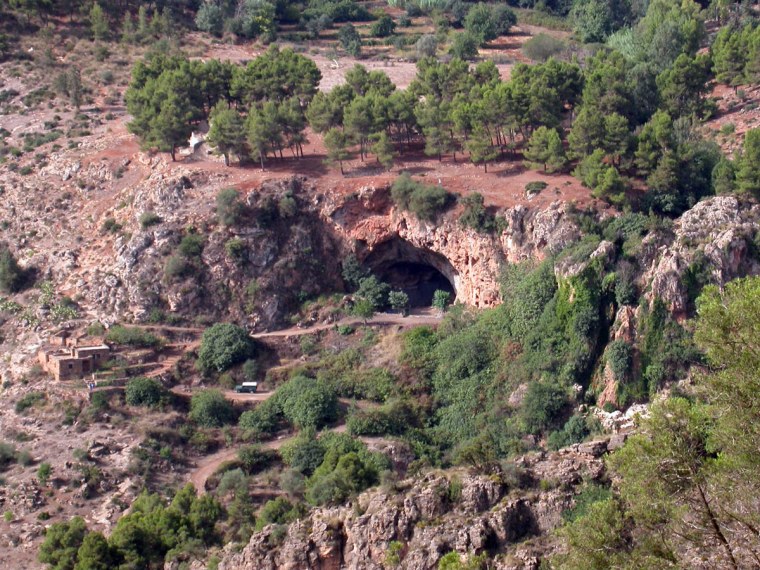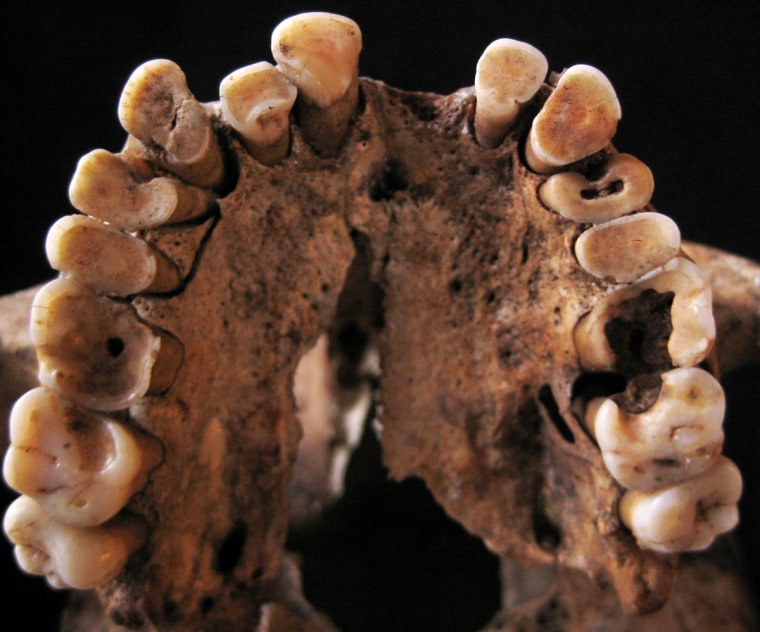Excruciating toothaches and pus-filled, swollen gums were a part of life for an ancient population of hunter-gatherers who regularly sat around the campfire feasting on acorns and pine nuts, according to a new study.
The starchy foods glommed onto the hunter-gatherers' teeth, providing nourishment to mouth-dwelling bacteria. These bacteria ferment carbohydrates and produce acid that "essentially dissolves away the enamel," Louise Humphrey, a human origins researcher at the Natural History Museum in London, told NBC News.
She and colleagues found cavities in more than half of the 52 teeth they examined from adult skeletons in a cemetery at the back of a cave in Morocco, a country in North Africa. The remains date to between 15,000 and 13,200 years ago, several thousand years before the origins of agriculture. Only three skeletons in the Taforalt cave showed no signs of cavities.
"It is unexpected to find this level of tooth decay in a hunter-gatherer population because, typically, they are not thought to consume such large quantities of carbohydrate-rich foods," Humphrey noted. Her team reported the finding online today in the Proceedings of the National Academy of Sciences.
While rare to find high-levels of tooth decay in hunter-gatherer populations, rotten teeth have also been observed in hunter-gatherer groups from southern Texas and northern Mexico, noted Peter Ungar, an archaeologist at the University of Arkansas in Fayetteville, who was not involved with the new study.
"When we find high (cavity) rates in hunter-gatherers, they are usually associated with carbohydrate-rich diets, and this underscores the role of sugars and starches in feeding the plaque bacteria that cause dental decay," he explained to NBC News in an email.

Sweet acorns and snails
Paleobotanists on the team identified 22 plant species among the charred remains. The most common is a type of sweet acorn that could be eaten raw but "they would've been more palatable if they were cooked and we think that they were cooking them," Humphrey said.
Though the hunter-gatherers lacked pots and pans for cooking, they could have boiled the nuts with scorching hot stones that they dropped into tightly-woven baskets or leather pouches filled with water. Grind stones found in the cave suggest at least some of the nuts were dried and ground into flour for making patties or cakes that were cooked on hot stones.
"We think (they) were systematically harvesting these acorns, bringing them back to the cave and eating them in sufficiently large quantities to alter the bacterial ecology of their mouths and leading to tooth decay," Humphrey said.
In addition to acorns and pine nuts, the hunter-gatherers at Taforalt ate large quantities of land snails, which are a good source of protein, but also gritty. The bits of sand and dirt in the snails, in turn, would have worn down the hunter-gatherers' teeth, Humphrey noted.
'A lot of pain'
"Teeth, when they wear, continue to emerge into the mouth … so people can keep on chewing their food," she said, explaining that over time the part that emerges is dentine, which is more easily decayed by the acids. Those who survived to old age, she said, chewed on dentine and exposed roots.
"They must have had a lot of pain," she said.
The researchers are unclear if the hunter-gatherers took anything for the pain. It's possible, for example, the nuts were used to make a porridge that was allowed to ferment into a soupy and mind-numbing beer.
"That would be really good," Humphrey noted. "But we don't have anything like that yet. That would be something that we should go back and look for … you could probably make something fermentable from the acorn."
John Roach is a contributing writer. He started this role in November 2005. Roach is responsible for environmental coverage on NBC News Digital. Roach has also contributed National Geographic News, MSN, and other outdoor and environment related publications. To learn more about him, visit his website.
